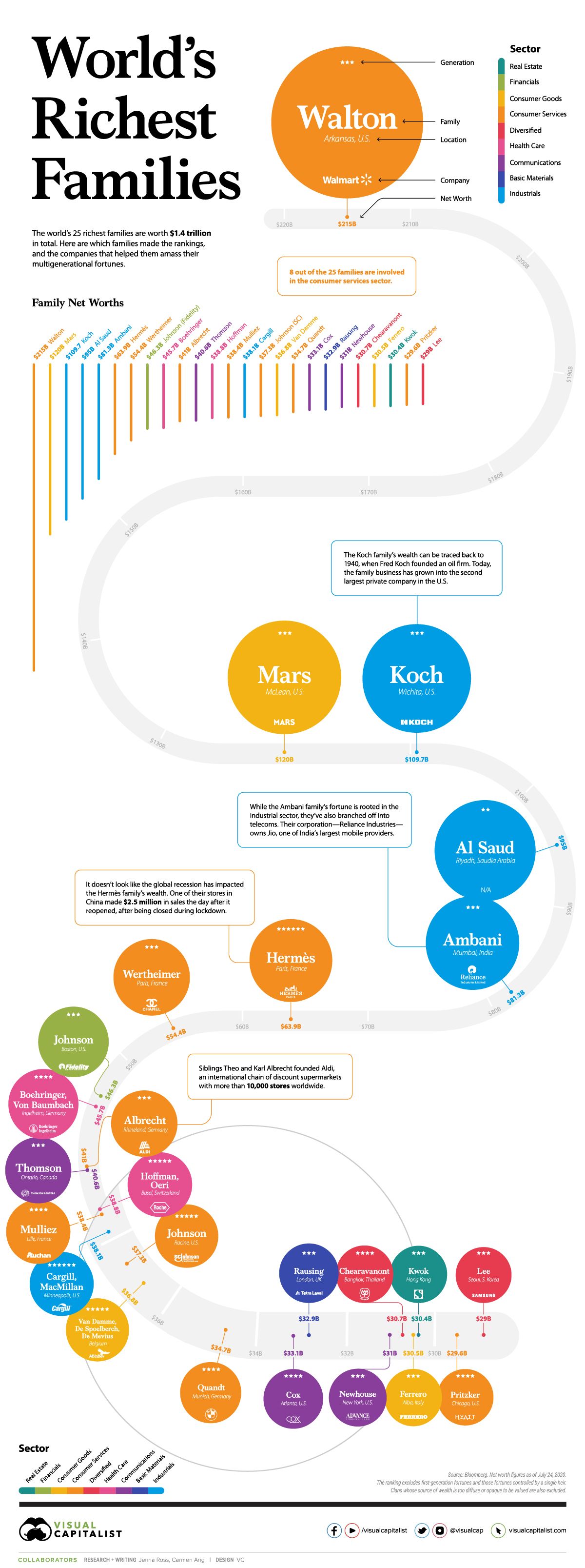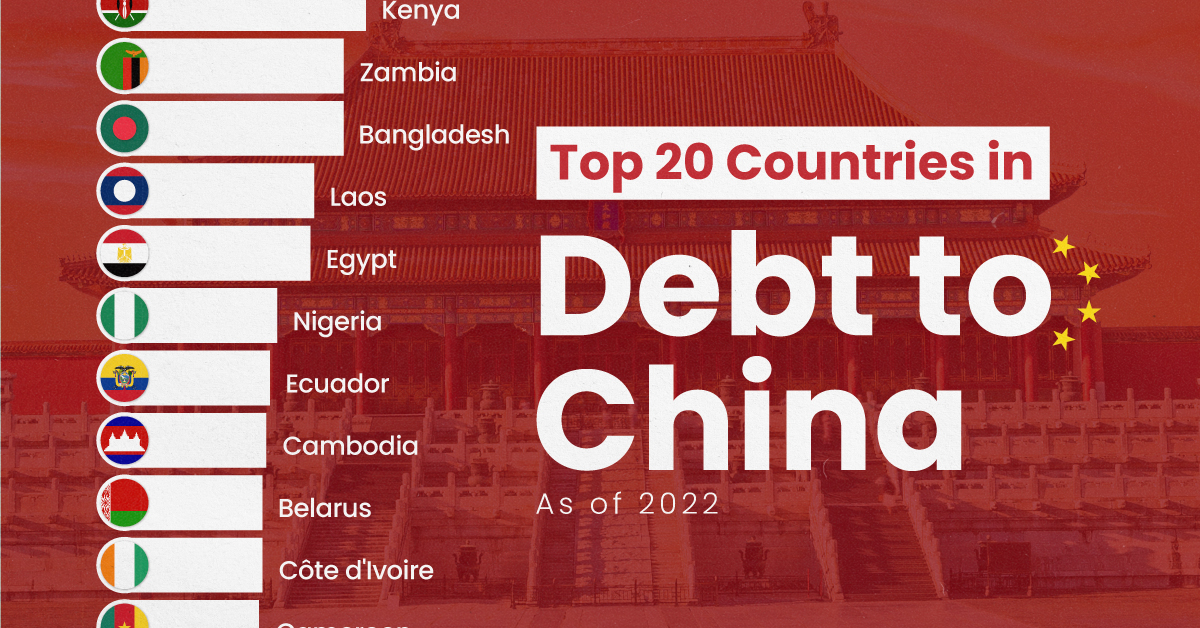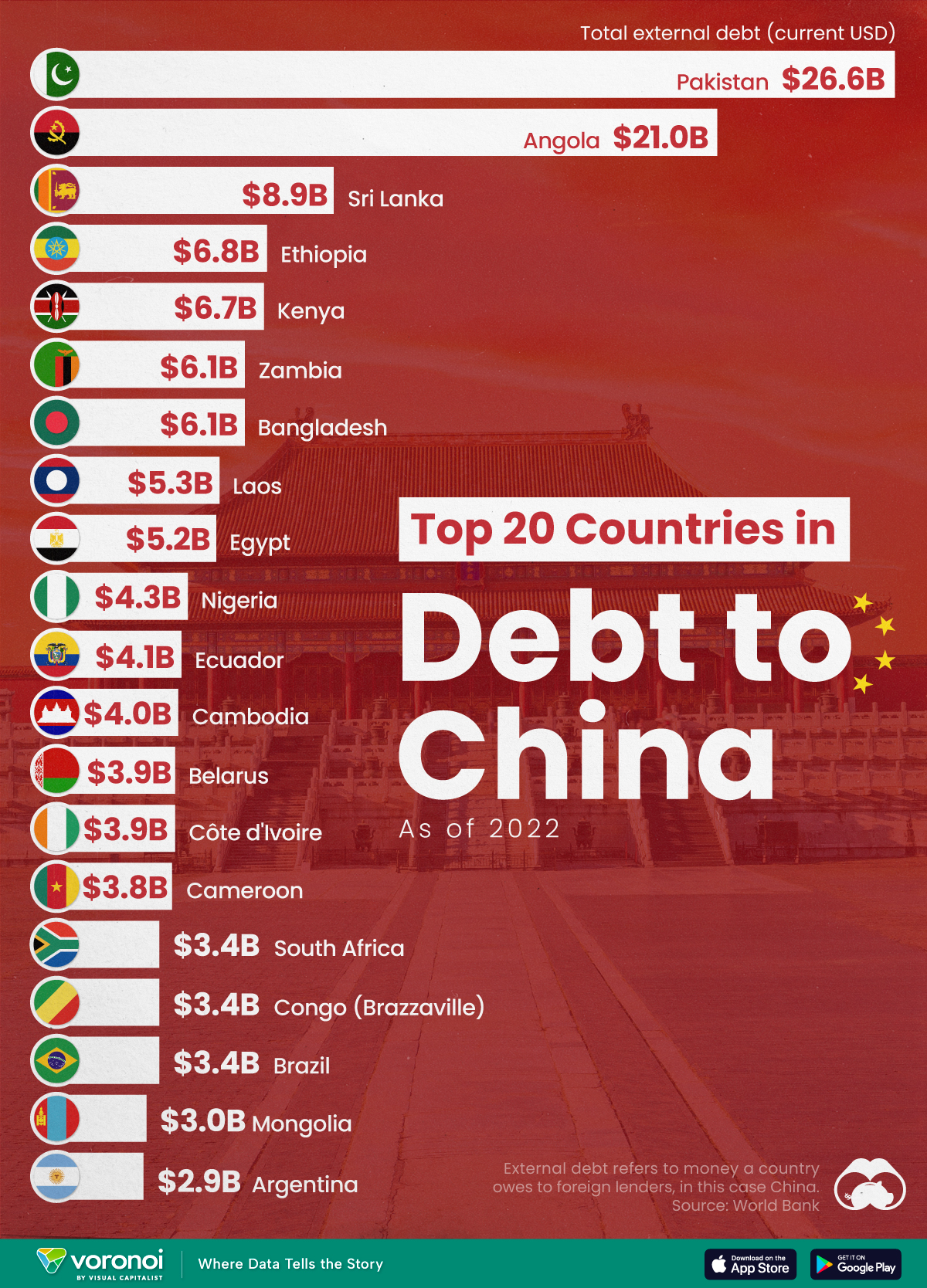Money
Ranked: The World’s Richest Families in 2020

The World’s Richest Families in 2020
The COVID-19 pandemic hasn’t stopped the world’s wealthiest families from growing their fortunes. Over the past year, the richest family—the Waltons—grew their wealth by $25 billion, or almost $3 million per hour.
This graphic, using data from Bloomberg, ranks the 25 most wealthy families in the world. The data excludes first-generation wealth and wealth controlled by a single heir, which is why you don’t see Jeff Bezos or Bill Gates on the list. Families whose source of wealth is too diffused or opaque to be valued are also excluded.
The Full Breakdown
Intergenerational wealth is a powerful thing. It often prevails through market crashes, social turmoil, and economic uncertainty, and this year has been no exception.
Here’s a look at the 25 most wealthy families in 2020:
| Rank | Name | Company | Wealth, $B | Sector | Location |
|---|---|---|---|---|---|
| 1 | Walton | Walmart | 215 | Consumer services | 🇺🇸 Bentonville, Arkansas |
| 2 | Mars | Mars | 120 | Consumer goods | 🇺🇸 McLean, Virginia |
| 3 | Koch | Koch Industries | 109.7 | Industrials | 🇺🇸 Wichita, Kansas |
| 4 | Al Saud | N/A | 95 | Industrials | 🇸🇦 Riyadh, Saudi Arabia |
| 5 | Ambani | Reliance Industries | 81.3 | Industrials | 🇮🇳 Mumbai, India |
| 6 | Hermès | Hermès | 63.9 | Consumer services | 🇫🇷 Paris, France |
| 7 | Wertheimer | Chanel | 54.4 | Consumer services | 🇫🇷 Paris, France |
| 8 | Johnson (Fidelity) | Fidelity Investments | 46.3 | Financials | 🇺🇸 Boston, New York |
| 9 | Boehringer, Von Baumbach | Boehringer Ingelheim | 45.7 | Health care | 🇩🇪 Inglheim, Germany |
| 10 | Albrecht | Aldi | 41 | Consumer services | 🇩🇪 Rhineland, Germany |
| 11 | Thomson | Thomson Reuters | 40.6 | Communication | 🇨🇦 Ontario, Canada |
| 12 | Hoffmann, Oeri | Roche | 38.8 | Health care | 🇨🇭 Basel, Switzerland |
| 13 | Mulliez | Auchan | 38.4 | Consumer services | 🇫🇷 Lille, France |
| 14 | Cargill, MacMillan | Cargill | 38.1 | Industrials | 🇺🇸 Minneapolis, Minnesota |
| 15 | Johnson (SC) | SC Johnson | 37.3 | Consumer services | 🇺🇸 Racine, Wisconsin |
| 16 | Van Damme, De Spoelberch, De Mevius | Anheuser-Busch InBev | 36.8 | Consumer goods | 🇧🇪 Belgium |
| 17 | Quandt | BMW | 34.7 | Consumer services | 🇩🇪 Munich, Germany |
| 18 | Cox | Cox Enterprises | 33.1 | Communication | 🇺🇸 Atlanta, Georgia |
| 19 | Rausing | Tetra Laval | 32.9 | Materials | 🇬🇧 London, England |
| 20 | Newhouse | Advance Publications | 31 | Communication | 🇺🇸 New York, New York |
| 21 | Chearavanont | Charoen Pokphand Group | 30.7 | Diversified | 🇹🇭 Bangkok, Thailand |
| 22 | Ferrero | Ferrero | 30.5 | Consumer goods | 🇮🇹 Alba, Italy |
| 23 | Kwok | Sun Hung Kai Properties | 30.4 | Real estate | 🇭🇰 Hong Kong |
| 24 | Pritzker | Hyatt Hotels | 29.6 | Consumer services | 🇺🇸 Chicago, Illinois |
| 25 | Lee | Samsung | 29 | Diversified | 🇰🇷 Seoul, South Korea |
*Note: The Al Saud’s net worth is based on cumulative payouts royal family members were estimated to have received over the past 50 years.
The Waltons are the richest family on the list by far, with a net worth of $215 billion—that’s $95 billion more than the second wealthiest family. Sam Walton, the family’s patriarch, founded Walmart in 1962. Since then, it’s become the world’s largest retailer by revenue.
When Sam passed away in 1992, his three children—James, Alice, and Rob—inherited his fortune. Now, the trio co-owns about half of Walmart.
In second place is the Mars family, with a net worth of $120 billion. The family is well-known for their candy empire, but interestingly, about half of the company’s value comes from pet care holdings. Mars Inc. owns several popular pet food brands, including Pedigree, Cesar, and Royal Canin—and it expanded its pet presence further in 2017 when it acquired VCA, a company with almost 800 small animal vet hospitals across the U.S. and Canada.
The Koch family is the world’s third-richest family. Their fortune is rooted in an oil firm founded by Fred C. Koch. Following Fred’s death in 1967, the firm was inherited by his four sons—Frederick, Charles, David, and William. After a family feud, Frederick and William left the business, and Charles and David went on to build the mega industrial conglomerate known as Koch Industries.
Despite being affected by the oil crash this year, the Koch family’s wealth still sits at $109.7 billion. Before David’s passing in 2019, he and his brother Charles were heavily involved in politics—and their political efforts were the subject of much scrutiny.
Richest Families, by Sector
It’s important to note that many of these families have diversified their investments across a variety of industries. For instance, while the Koch family’s wealth is largely concentrated in the industrial sector and commodities, they also dabble in real-estate—in May 2020, they made a $200 million bet on U.S. rental homes.
That being said, it’s interesting to see where each of these families started, and which sectors have bred the highest number of ultra-wealthy families.
Here’s a breakdown of each sector and how many families on the list got started in them:
| Sector | Number of Families | Total Wealth, $B |
|---|---|---|
| Consumer Services | 8 | 514.3 |
| Industrials | 4 | 324.1 |
| Consumer Goods | 3 | 187.3 |
| Communications | 3 | 104.7 |
| Health Care | 2 | 84.5 |
| Diversified | 2 | 59.7 |
| Financials | 1 | 46.3 |
| Basical Materials | 1 | 32.9 |
| Real Estate | 1 | 30.4 |
The top sector is consumer services—8 of the 25 families are heavily involved in this sector. Walmart helped generate the most wealth out of families in this space, while luxury brands Hermès and Chanel were the source of fortune for the next two wealthiest families.
Industrial is the second largest sector, with 4 of the 25 families involved. It’s also one of the most lucrative sectors—out of the top five wealthiest families on the list, three are in industrials. The Koch family is the wealthiest family in this category, followed by the Al Saud family and the Ambani family, respectively.
Communications and consumer goods are tied for third, with 3 of the 25 families in each. The Thomsons, who founded Thomson Reuters, are the wealthiest family in communications, while the Mars family has the highest net worth in the consumer goods sector.
Resilient, but not Bulletproof
Despite a global recession, most of the world’s wealthiest families seem to be doing just fine—however, not everyone on the list has been thriving this year.
The Koch family’s fortune dropped by $15 billion from 2019 to 2020, and the current political climate in Hong Kong has had a negative impact on the Kwok family’s real estate empire.
While intergenerational wealth certainty has resilience, how much economic and social turmoil can it withstand? It’ll be interesting to see which families make the list in 2021.
Economy
Ranked: The Top 20 Countries in Debt to China
The 20 nations featured in this graphic each owe billions in debt to China, posing concerns for their economic future.

Ranked: The Top 20 Countries in Debt to China
This was originally posted on our Voronoi app. Download the app for free on iOS or Android and discover incredible data-driven charts from a variety of trusted sources.
In this graphic, we ranked the top 20 countries by their amount of debt to China. These figures are as of 2022, and come from the World Bank (accessed via Yahoo Finance).
The data used to make this graphic can be found in the table below.
| Country | Total external debt to China ($B) |
|---|---|
| 🇵🇰 Pakistan | $26.6 |
| 🇦🇴 Angola | $21.0 |
| 🇱🇰 Sri Lanka | $8.9 |
| 🇪🇹 Ethiopia | $6.8 |
| 🇰🇪 Kenya | $6.7 |
| 🇧🇩 Bangladesh | $6.1 |
| 🇿🇲 Zambia | $6.1 |
| 🇱🇦 Laos | $5.3 |
| 🇪🇬 Egypt | $5.2 |
| 🇳🇬 Nigeria | $4.3 |
| 🇪🇨 Ecuador | $4.1 |
| 🇰🇭 Cambodia | $4.0 |
| 🇨🇮 Côte d'Ivoire | $3.9 |
| 🇧🇾 Belarus | $3.9 |
| 🇨🇲 Cameroon | $3.8 |
| 🇧🇷 Brazil | $3.4 |
| 🇨🇬 Republic of the Congo | $3.4 |
| 🇿🇦 South Africa | $3.4 |
| 🇲🇳 Mongolia | $3.0 |
| 🇦🇷 Argentina | $2.9 |
This dataset highlights Pakistan and Angola as having the largest debts to China by a wide margin. Both countries have taken billions in loans from China for various infrastructure and energy projects.
Critically, both countries have also struggled to manage their debt burdens. In February 2024, China extended the maturity of a $2 billion loan to Pakistan.
Soon after in March 2024, Angola negotiated a lower monthly debt payment with its biggest Chinese creditor, China Development Bank (CDB).
Could China be in Trouble?
China has provided developing countries with over $1 trillion in committed funding through its Belt and Road Initiative (BRI), a massive economic development project aimed at enhancing trade between China and countries across Asia, Africa, and Europe.
Many believe that this lending spree could be an issue in the near future.
According to a 2023 report by AidData, 80% of these loans involve countries in financial distress, raising concerns about whether participating nations will ever be able to repay their debts.
While China claims the BRI is a driver of global development, critics in the West have long warned that the BRI employs debt-trap diplomacy, a tactic where one country uses loans to gain influence over another.
Editor’s note: The debt shown in this visualization focuses only on direct external debt, and does not include publicly-traded, liquid, debt securities like bonds. Furthermore, it’s worth noting the World Bank data excludes some countries with data accuracy or reporting issues, such as Venezuela.
Learn More About Debt from Visual Capitalist
If you enjoyed this post, check out our breakdown of $97 trillion in global government debt.
-

 Wealth6 days ago
Wealth6 days agoCharted: Which City Has the Most Billionaires in 2024?
-

 Mining2 weeks ago
Mining2 weeks agoGold vs. S&P 500: Which Has Grown More Over Five Years?
-

 Uranium2 weeks ago
Uranium2 weeks agoThe World’s Biggest Nuclear Energy Producers
-

 Education2 weeks ago
Education2 weeks agoHow Hard Is It to Get Into an Ivy League School?
-

 Debt2 weeks ago
Debt2 weeks agoHow Debt-to-GDP Ratios Have Changed Since 2000
-

 Sports2 weeks ago
Sports2 weeks agoThe Highest Earning Athletes in Seven Professional Sports
-

 Science2 weeks ago
Science2 weeks agoVisualizing the Average Lifespans of Mammals
-

 Brands1 week ago
Brands1 week agoHow Tech Logos Have Evolved Over Time















